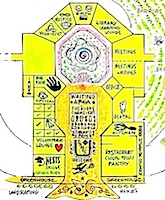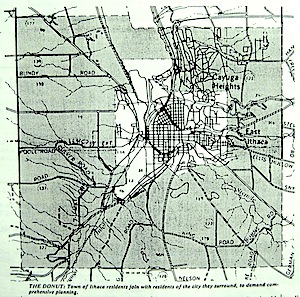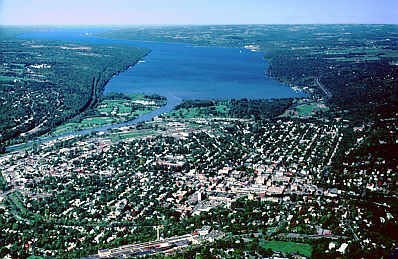




 |
 |
 |
 |
 |
| PAUL
GLOVER ESSAYS: community
control of food, fuel, housing, health care,
planning, education, finance. |
| HOME | INTRO | CURRENCY | SUCCESSES | HOW-TO BOOK | PUBLICITY | ESSAYS |
|
SERVING
THE DONUT by Paul Glover, The Grapevine, June 1988 Within the past two weeks, Town of Ithaca residents joined forces to overrule the Town Supervisor, to pressure rejections of proposed developments on both West and South hills, and to lecture the Town Planning Board about propoer planning. Last week, on June 16, neighborhood representatives from the City, from the Town's West, South and East hills, from Lansing and Cayuga Heights established the Greater Ithaca Neighborhoods Association. Many at these meetings have lived here a long time and are angry at the ruin of wild land, the attack on quiet places and the unmanageable increase of traffic. Others have recently arrived from frenzied ugly places, half-bankrupt cities, stinking dumps of crime and noise, and they intend to protect this place for their children. They know what could happen here.  Ithaca's
town has become a boom town, and the explosion sounds good to
developers and speculators. The Town of Ithaca's eight
percent population increase since 1980 is the fastest in New York state
this decade, while the state has lost two percent. During the
past five years the Town has loaded itself with over $35 million of new
construction, bringing about a 42 percent tax rate increase.
Communities which have studied sprawl find that, where developers
profit, average taxpayers pay more for water, sewer, fire, police,
schools and roads. Ithaca's
town has become a boom town, and the explosion sounds good to
developers and speculators. The Town of Ithaca's eight
percent population increase since 1980 is the fastest in New York state
this decade, while the state has lost two percent. During the
past five years the Town has loaded itself with over $35 million of new
construction, bringing about a 42 percent tax rate increase.
Communities which have studied sprawl find that, where developers
profit, average taxpayers pay more for water, sewer, fire, police,
schools and roads.But the new Democratic majority on the Town Board, elected by campaigning for comprehensive planning, made their move June 13 by prevailing to hire an independent local consultant to organize a comprehensive plan. Speaking for the South Hill Community Association, Myrtle Whitcomb said, "Such a plan should be developed jointly between Town officials and representatives from the community at large. Adoption of this new plan should occur only after seeking local input and exhaustive research on demographics, environmental concerns, traffic patterns and the quality of life desired by the current residents." Thus everyone is elected, to think broadly about the kind of place we intend this area to become. Time has come to tell representatives what planning is for. What Planning is For PLanning is the people's right to keep the Town healthy and easy to live in, to put it on a path which will give pleasure to hundreds of thousands during the next hudred years. To make a new start, Ithaca need only follow excellent examples set by many American communities which have enacted sprawl controls (see sidebar). First and most usual is the moratorium for comprehensive planning. New York state communities have stopped additional developments for as long as two years, while residents examine the effects of suburbanization on their lives. They take enough time to make a plan which profoundly satisfies them. Second of these usually is an annual limit to the number of building permits. Rather than issue permits for an average 50 new units per year, the Town could approve, say, a maximum 30 units annually and issue them to those whose housing would be heaviest insulated or earth-sheltered, affordable, adjacent to bus routes, of limited-equity, solarized and in other ways beneficial to the community. This measure would stabilize land and housing prices by cooling the speculative fever. It would signal Cornell that unless it builds on campus, its expansion is limited by Ithaca's pace of housing production, and that Ithaca intends to be a partner in university planning. This signals investors likewise that Ithaca is not a lottery, not a game-show, but a community. Thirdly new housing would pay a three percent construction value tax, to fund afforable housing, to purchase greenspace and bikeway right-of-way, to support daycare, youth services and such projects as an Ithaca Town and country Fair, recycling bins and an East Hill Farmers' Market. If this fee had been enacted just five years ago, the Town would have collected over $1,000.000 for such purposes. What Comprehensive Planning Does Just as there is a big difference between sprawl and growth, there is a big difference between zoning and comprehensive planning. Zoning and subdivision regulations-- and even Environmental Quality Review-- ask questions one parcel at a time. Zoning asks how many units may be built on what portion of one lot, what size the lot must be and what road setback is minimum. These are important but not a substitute for comprehensive planning. Comprehensive planning asks larger questions like: how many new houses can be put on West Hill, South Hill and East Hill before the |
 volume of commuters coming out of them makes commuting hell for everyone (regardless of road size), and cross-city routes (on Seneca, Meadow and Green Streets) nearly impassable. Comprehensive planning considers whether the Town of Ithaca will welcome any businesses that make jobs, or will it prefer those which provide creative and environmentally beneficial work, whose product can be used locally, whose profits are spent locally, whose investors are local people and whose operation pays all taxes needed to carry that business' burden on added public services. Comprehensive planning foresees what proportion of our watershed and recharge basins may be occupied before the water table sinks, before pollution carried to creeks dangerously contaminates Cayuga Lake, before the only view remaining is of each other. Ithacans increasingly recognize that the fundamentals of a practical society are clean water and air, fertile soil, efficient transport and fuel conservation, which keep us healthy, fed, warm and mobile. They've begun asking hard-nosed bottom-line questions about balancing people and commerce with nature. Rather than degrading this piece of America by fouling water, destroying agricultural soil, wasting fuels and throwing essential resources into landfills, many Ithacans would offer leadership to: * Design the tools, neighborhoods, transport, housing and fuel systems and legislation which best protect and cycle nature; * Assess the long-range reliability of imported food and fuel supplies, and prepare to increase local production; * Measure surface and groundwater quality, soils, forest and microclimates to accomplish the above; * Teach ourselves and or children better ways to live. We have many constructive alternatives. We are an ingenious good-hearted people, one of the most educated electorates in the world living in one of the most beautiful places on earth. We can choose better development for ourselves and generations to follow. The organization formed last week is a beginning of that choice; a surging public resolve that Ithaca's progress hereafter respect the future as well as the dollar. Sprawl Control Resources Greater Ithaca Neighborhoods Association Promotes helathy development and coordinates community opposition to sprawl, welcomes new members from throughout the county. Community Land Trust Association, supports groups which are "community organizations, usually nonprofit organizations, that hold rural or urban land in trust to ensure its ecological use and access to local citizens." The Trust for Public Land Provides community groups with training and technical assistance in land aquisition. Planners Network National newsletter of democratic planning for public good rather than for special interests. Zoning Practice Monthly newsletter of zoning options by American Planning Association Acres, USA Newspaper of farmland preservation and ecological agriculture. |
 |